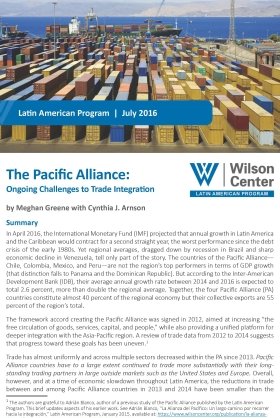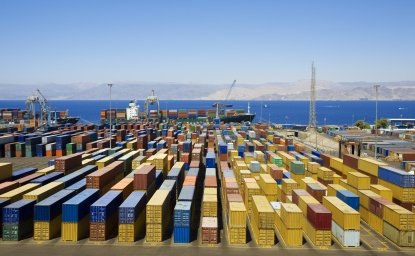The Pacific Alliance: Ongoing Challenges to Trade Integration


In April 2016, the International Monetary Fund (IMF) projected that annual growth in Latin America and the Caribbean would contract for a second straight year, the worst performance since the debt crisis of the early 1980s. Yet regional averages, dragged down by recession in Brazil and sharp economic decline in Venezuela, tell only part of the story. The countries of the Pacific Alliance—Chile, Colombia, Mexico, and Peru—are not the region’s top performers in terms of GDP growth (that distinction falls to Panama and the Dominican Republic). But according to the Inter-American Development Bank (IDB), their average annual growth rate between 2014 and 2016 is expected to total 2.6 percent, more than double the regional average. Together, the four Pacific Alliance (PA) countries constitute almost 40 percent of the regional economy but their collective exports are 55 percent of the region’s total.
The framework accord creating the Pacific Alliance was signed in 2012, aimed at increasing “the free circulation of goods, services, capital, and people,” while also providing a unified platform for deeper integration with the Asia-Pacific region. A review of trade data from 2012 to 2014 suggests that progress toward these goals has been uneven.
Trade has almost uniformly and across multiple sectors decreased within the PA since 2013. Pacific Alliance countries have to a large extent continued to trade more substantially with their longstanding trading partners in large outside markets such as the United States and Europe. Overall, however, and at a time of economic slowdown throughout Latin America, the reductions in trade between and among Pacific Alliance countries in 2013 and 2014 have been smaller than the reductions in each country’s bilateral trade with Argentina and Brazil, South America’s two largest markets. This points to the greater stability of trade within the Pacific Alliance.
A closer look at the data indicates that some countries have performed better that the aggregate PA figures would suggest. Particularly noteworthy is the case of Colombia, which between 2013 and 2014 was the only country to increase its percentage of exports to and imports from Asia’s three largest markets: China, Japan, and South Korea. Some of the increase in bilateral trade as a percentage of total trade is due to the fact that Colombia is rather new to Asian markets. Nevertheless, the increase is nothing short of impressive.
While the aggregate picture of the PA shows little across-the-board success in improving intra-industry trade (the kind that creates value chains), Peru is performing relatively well in comparison to the other Pacific Alliance countries in terms of increasing exports to other Alliance members and achieving major improvements in the level of intra-industry trade, especially in the food products sector.
Exports from Brazil and Argentina—South America’s two largest economies—to China, Japan, and South Korea decreased across the board from 2013 to 2014, while some Pacific Alliance members were able to increase exports to the three largest Asian markets. Thus, in relative terms, members of the Pacific Alliance exhibited stronger export performance vis-à-vis Asian markets than did the two largest South American economies.
All in all, the relatively stronger performance of Pacific Alliance members vis-à-vis several Asian countries during a period of recessionary shocks indicates that Alliance members are—despite obstacles—making headway in bolstering trade relations with Asian partners, a key goal of Pacific Alliance integration.
Data over a longer period of time are needed to shed light on the future potential of the agreement as Latin America and the global economy continue to navigate a complex and challenging environment.
Authors


Latin America Program
The Wilson Center’s prestigious Latin America Program provides non-partisan expertise to a broad community of decision makers in the United States and Latin America on critical policy issues facing the Hemisphere. The Program provides insightful and actionable research for policymakers, private sector leaders, journalists, and public intellectuals in the United States and Latin America. To bridge the gap between scholarship and policy action, it fosters new inquiry, sponsors high-level public and private meetings among multiple stakeholders, and explores policy options to improve outcomes for citizens throughout the Americas. Drawing on the Wilson Center’s strength as the nation’s key non-partisan policy forum, the Program serves as a trusted source of analysis and a vital point of contact between the worlds of scholarship and action. Read more




